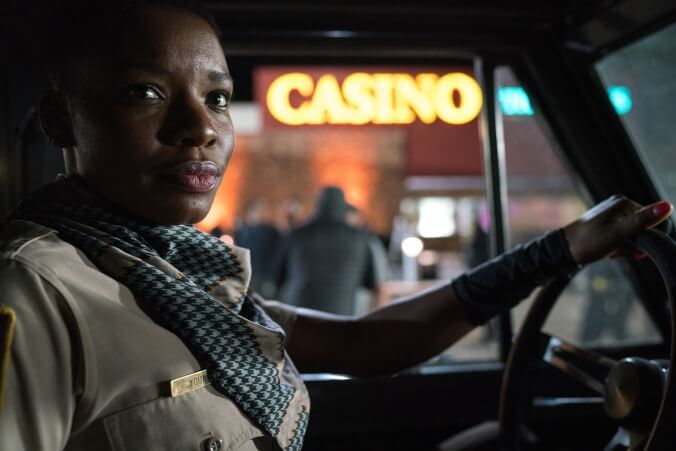The gift of gab ranks among the chief virtues of Joe Carnahan’s latest action gem Copshop, but prior to the hard-boiled wisecracks and stylized snippets of gutter poetry, he says it all without saying a word. The film opens with a funky bassline, its congas-and-bongos percussion groove teasing the Curtis Mayfield cut that’ll close out this marvelously nasty specimen of the retro crime thriller, and a close-up of a revolver finger-spun into its holster. Factor in the Nevadan desert background, and two things about the film to come are promptly made clear: one, that we’re headed back to the ’70s heyday of B-movie pulp, and two, that Carnahan’s trafficking in the subcategory of Western-influenced cop-and-robber pictures that explore the full potential of creative firearm use. There’s shooting and then there’s gunslinging, and the raw panache on display here will soon clarify the difference between the two.
As of late, S. Craig Zahler has stepped in as the primary steward of this hard-nosed, merciless genre filmmaking tradition, bringing with him an unsavory reactionary streak. Carnahan ditches the regrettable racial stuff (though his attempt at a corrective is often imperfect in its own way) and keeps the casual sadism, the inspired paperback dialogue, the unhurried pacing, the modest scale puffed up by resourcefulness, and the tightly controlled spatial awareness. This scuzzy milieu may have a low-rent history, but Carnahan’s formal proficiency makes for a more sharpened and accomplished piece of work than many modern counterparts attempting to draw from the same well of cheap-o homage. That sense of precision doesn’t detract from the down-and-dirty fun, either; everyone on screen appears to be having the time of their lives gnawing on the rare slab of beef they’ve been thrown.
With Tommy Wiseau tresses held together in a rightly ridiculed man-bun, Frank Grillo is first to embrace the eccentric characterization that brings your average potboiler to a higher bubble. He’s Teddy Muretto, a flim-flam man and professional fixer, though he hates that last word. He “creates opportunities” for the muckety mucks of Las Vegas—in the just-shy-of-overwritten script, everyone’s words are carefully chosen—with one such job having landed him in the crosshairs of hitman Bob Viddick (Gerard Butler, one notch nuttier, right in the sweet spot). With nowhere else to go, a panicking Teddy figures the safest place to be is a jail cell, so he cold-cocks police officer Valerie Young (Alexis Louder) and gets escorted to the station in the suburb of Gun Creek. Doesn’t take long for Bob to fake a DUI and land himself in a cell just out of arm’s reach of his target, and so the game is on.
Without much straying beyond the walls of the precinct, save a couple key flashbacks, Carnahan maintains a propulsive energy in his deceptively complicated, multi-pronged plot. While Bob and Teddy trade ornate tough-guy barbs in the vault-secure brig, another assassin (Toby Huss, taking the loosey-goosey antics just a little too far) keen on Teddy’s head storms onto the scene and things take a turn for the Assault On Precinct 13. It’s at this point that Val can emerge as the true protagonist of this blood-spattered mess, a morally upstanding bulwark against the criminality out on the streets and the kind festering within her department.
That Val is a woman of color draws attention to political dissonances between the film’s modern setting and its old-school ethic. Carnahan makes an effort to reckon with what a cop picture means in This Day And Age while staying true to the rough edge of his ancestors, a clash that bodes more poorly for the former pursuit. We’re meant to get a good chuckle out of Val double-tasing Teddy while he’s already writhing in pain on the ground, an image that goes down easier when it’s a Black female officer roughing up a white man. It’s an easy way out that short-changes Val, simplified to a superhuman in honorable character and inexplicable resistance to bullet wounds.
The physics of getting shot and dying can sometimes undermine the built-up tensions, a few characters withstanding what appear to be killing strokes without explanation. But it’s easy to turn a blind eye to logistics when there’s a masterfully choreographed and edited multi-phase firefight to keep audiences occupied, the climactic showdown between the four at-odds parties splayed out over a solid hour. Panes of bulletproof glass, prison bars, and impenetrable steel hatches pose narrative hurdles that Carnahan blasts through with imagination and finesse, his cast more than up to the agile stuntwork. Their gameness extends to the performances as well, a uniform willingness to go for broke that harkens back to a more colorfully ragged era of exploitation. The film only falters when trying to acknowledge the present-day awareness that the good old days were not always so good, as if it would rather seal itself off in its notion of the past. Those nostalgic for the time when Harry Callahan and his gristly cohorts reigned supreme will be all too happy to join it there.


 Keep scrolling for more great stories from A.V. Club.
Keep scrolling for more great stories from A.V. Club.